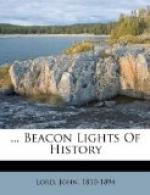had such great influence on the youthful Thomas that
he resolved to join the Order, and at the age of seventeen
became a Dominican friar, to the disappointment of
his family. His mother Theodora went to Naples
to extricate him from the hands of the Dominicans,
who secretly hurried him off to Rome and guarded him
in their convent, from which he was rescued by violence.
But the youth persisted in his intentions against
the most passionate entreaties of his mother, made
his escape, and was carried back to Naples.
The Pope, at the solicitation of his family, offered
to make him Abbot of Monte Cassino, but he remained
a poor Dominican. His superior, seeing his remarkable
talents, sent him to Cologne to attend the lectures
of Albertus Magnus, then the most able expounder of
the Scholastic Philosophy, and the oracle of the universities,
who continued his lectures after he was made a bishop,
and even until he was eighty-five. When Albertus
was transferred from Cologne to Paris, where the Dominicans
held two chairs of theology, Thomas followed him,
and soon after was made bachelor. Again was
Albert sent back to Cologne, and Thomas was made his
assistant professor. He at once attracted attention,
was ordained priest, and became as famous for his sermons
as for his lectures. After four years at Cologne
Thomas was ordered back to Paris, travelling on foot,
and begging his way, yet stopping to preach in the
large cities. He was still magister and Albert
professor, but had greatly distinguished himself by
his lectures.
His appearance at this time was marked. His
body was tall and massive, but spare and lean from
fasting and labor. His eyes were bright, but
their expression was most modest. His face was
oblong, his complexion sallow; his forehead depressed,
his head large, his person erect.
His first great work was a commentary of about twelve
hundred pages on the “Book of Sentences,”
in the Parma edition, which was received with great
admiration for its logical precision, and its opposition
to the rationalistic tendencies of the times.
In it are discussed all the great theological questions
treated by Saint Angustine,—God, Christ,
the Holy Spirit, grace, predestination, faith, free-will,
Providence, and the like,—blended with
metaphysical discussions on the soul, the existence
of evil, the nature of angels, and other subjects
which interested the Middle Ages. Such was his
fame and dialectical skill that he was taken away
from his teachings and sent to Rome to defend his Order
and the cause of orthodoxy against the slanders of
William of Saint Amour, an aristocratic doctor, who
hated the Mendicant Friars and their wandering and
begging habits. William had written a book called
“Perils” in which he exposed the dangers
to be apprehended from the new order of monks, in
which he proved himself a true prophet, for ultimately
the Mendicant Friars became subjects of ridicule and
reproach. But the Pope came to the rescue of
his best supporters.




